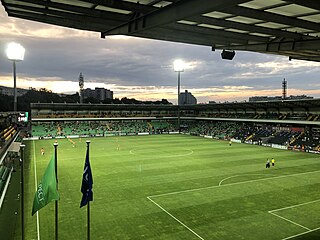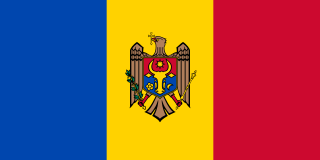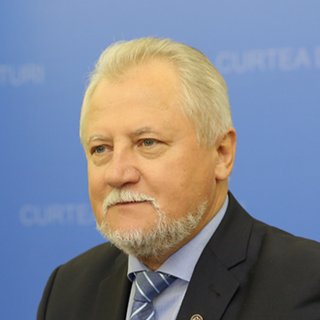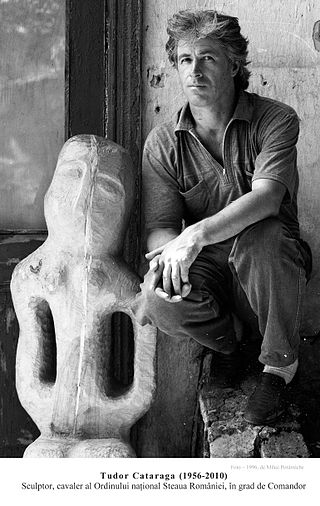
This is a list of museums in Moldova .

This is a list of museums in Moldova .

Chișinău is the capital and largest city of Moldova. The city is Moldova's main industrial and commercial centre, and is located in the middle of the country, on the river Bîc, a tributary of the Dniester. According to the results of the 2014 census, the city proper had a population of 532,513, while the population of the Municipality of Chișinău was 700,000. Chișinău is the most economically prosperous locality in Moldova and its largest transportation hub. Nearly a third of Moldova's population lives in the metro area.

Ungheni is a municipality in Moldova. With a population of 35,157, it is the seventh largest town in Moldova and the seat of Ungheni District.

Moldova's constitution provides for freedom of religion and complete separation of church and state, though the constitution cites the "exceptional importance" of Eastern Orthodox Christianity. Discrimination on the basis of religious affiliation is illegal, and incitement to religious and ethnic hatred was made illegal in May 2022. Religion in Moldova is dominated by the Eastern Orthodox branch of Christianity. According to the 2014 Moldovan census, 90 per cent of the country reported to be of the Eastern Orthodox Christian faith. Of this number, around eighty to 90 per cent of Orthodox Moldovans belong to the Moldovan Orthodox Church which is subordinate to the Russian Orthodox Church, and has played a powerful role in deepening Russia's influence in Moldova. The remaining 10–20 per cent of Orthodox Moldovans belong to the Metropolis of Bessarabia, which is subordinate to the Romanian Orthodox Church.

The history of the Jews in Moldova reaches back to the 1st century BC, when Roman Jews lived in the cities of the province of Lower Moesia. Bessarabian Jews have been living in the area for some time. Between the 4th-7th centuries AD, Moldova was part of an important trading route between Asia and Europe, and bordered the Khazar Khaganate, where Judaism was the state religion. Prior to the Second World War, violent antisemitic movements across the Bessarabian region badly affected the region's Jewish population. In the 1930s and '40s, under the Romanian governments of Octavian Goga and Ion Antonescu, government-directed pogroms and mass deportations led to the concentration and extermination of Jewish citizens followed, leading to the extermination of between 45,000-60,000 Jews across Bessarabia. The total number of Romanian and Ukrainian Jews who perished in territories under Romanian administration is between 280,000 and 380,000.

The Super Liga is an association football league that is the top division of Moldovan football league system. The competition was established in 1992, when Moldova became independent from the Soviet Union. It was formed in place of former Soviet republican competitions that existed since 1945. Before the Soviet occupation of Bessarabia and Northern Bukovina in 1940, clubs from modern Moldova competed in the Romanian football competitions, particularly Nistru Chișinău.

Fotbal Club Zimbru Chișinău, commonly known as Zimbru Chișinău or simply Zimbru, is a Moldovan professional football club based in Chișinău, which competes in the Super Liga, the highest tier of Moldovan football.

The Zimbru Stadium is a football-specific stadium in Chișinău, Moldova, completed in May 2006 with a capacity of 10,104 people, meeting all norms required by UEFA and FIFA for national and international matches.

Sectorul Centru is one of the five sectors in Chișinău, the capital of Moldova. The local administration is managed by a pretor appointed by the city administration. It governs over a portion of the city of Chișinău itself, and the suburban town of Codru. It is largely populated by Moldovans and Romanians.

Sectorul Buiucani is one of the five sectors in Chişinău, the capital of Moldova, and the most affluent. The local administration is managed by a pretor appointed by the city administration. It governs over a portion of the city of Chişinău itself, the cities/towns of Durleşti and Vatra, and the communes of Condriţa, Ghidighici, and Truşeni. It is largely populated by Moldovans.

The following outline is provided as an overview of and topical guide to Moldova:
The 2008–09 Moldovan National Division was the 18th season of top-tier football in Moldova. The season started on 2 July 2008 and ended on 17 May 2009.

The National History Museum of Moldova is a museum in Central Chişinău, Moldova.

The Capitoline Wolf is a monument in Central Chișinău, Moldova. It is located in front of the National History Museum of Moldova.

Gheorghe E. Cojocaru is a historian from the Republic of Moldova.

Tourism in the Republic of Moldova focuses on the country's natural landscapes and its history. Wine tours are offered to tourists across the country. Vineyards/cellars include Cricova, Purcari, Ciumai, Romanești, Cojușna, Mileștii Mici. In 2015, Moldova received 2.85 million visitors.
The Republic of Moldova has a universal health care system.

Veaceslav Untilă is a Moldovan politician.

Tudor Cataraga was a sculptor from the Republic of Moldova.

The National Museum of Fine Arts of Moldova is a museum in Chișinău, Moldova, founded in November 1939 by Alexandru Plămădeală and Auguste Baillayre.
The following is a timeline of the history of the city of Chișinău, Republic of Moldova.